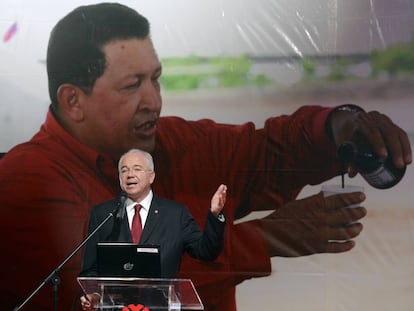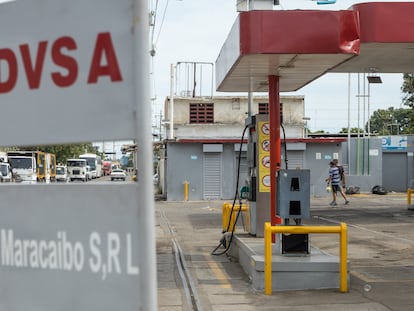$18 million in paintings: The mastermind who plundered Venezuela’s state oil company used his stolen funds to buy art
Venezuelan businessman Diego Salazar – the cousin of former minister Rafael Ramírez – accumulated a personal art collection of 67 works. He did this while leading a plot to money-launder $2 billion in Andorra, which he and his fellow Chavistas embezzled from Petróleos de Venezuela (PDVSA)

The Descent is an 1897 painting by the Venezuelan realist master, Arturo Michelena. Considered to be one of Latin America’s outstanding artistic figures from the 19th century, Michelena – whose body of work is famous for breaking records at Sotheby’s auctions in New York – is also the favorite of Venezuelan businessman Diego Salazar. This shadowy figure is allegedly one of the brains behind a network of about 30 former top Chavistas, tied to the governments of Hugo Chávez (1999-2013) and Nicolás Maduro (2013-present). This group looted over $2 billion from the state-owned oil company, Petróleos de Venezuela SA (PDVSA).
Along with The Descent – valued at $935,000 in 2008 – Salazar owned a total of 19 works by Michelena. Overall, his personal art collection swelled to 67 pieces by renowned Venezuelan creators. Artists such as Armando Reverón, Federico Brandt, Antonio Herrera Toro, Tito Salas, César Rengifo, Jesús Soto and Manuel Cabré make up the businessman’s artistic loot.
In 2008, the market value of this collection amounted to $18 million, according to a confidential report that EL PAÍS has had access to. The Andorran Financial Intelligence Unit (Uifand) – the body of the small Pyrenean country that is investigating Salazar for money laundering – affirmed this figure in a document from November of 2022.
A cousin of Rafael Ramírez – Venezuela’s former minister of petroleum, president of PDVSA and Venezuelan ambassador to the UN – Salazar accumulated his treasure between 2008 and 2009, when he supposedly piloted the embezzlement network. He also acted as one of the leaders of a group that made money by collecting bribes from companies – mostly Chinese firms – that were later awarded energy contracts by the Venezuela regime. Former Chavista vice ministers of energy – Nervis Villalobos and Javier Alvarado – were part of this group.
The selection by Salazar de Michelena (1863-1898) includes realist pieces such as Las niñas Lola y María Isabel Herrera (valued at $782,000), Los morochos Aguerrevere Herrera ($750,000), Purgatory ($747,500), La pica ($632,500), Nature’s death ($580,000), Youth and old age ($330,000), April 19 ($402,500), Portrait of a woman with doves ($368,000), Portrait of a woman ($258,750), Jesus in the garden ($280,000), Baptism ($253,000) and Portrait of María Ibarra de Matos ($250,000).
In 2008, the personal art gallery belonging to one of the masterminds behind the plundering of PDVSA also contained 11 pieces by Armando Reverón (1889-1954), a reference in 20th-century Latin American plastic arts. He was nicknamed “El loco de Macuto” (“the crazy man of Macuto”) for having lived and worked while isolated in a cabin in a small town along the Venezuelan coast.
Reverón’s painting – The Three Graces, from 1945 – is the jewel of Salazar’s collection. It is worth $1.3 million, according to a 2008 appraisal by the Muci Art Gallery in Caracas, which was mentioned in the report filed by the Andorran police investigators.
The collection owned by Rafael Ramírez’s cousin also includes works such as Reverón Úveros azules (valued at $825,000), Corporation of the Port of La Guaira ($724,500), Sitting Woman ($661,250), Nude ($550,000), Coconut Trees ($550,000), Dock with crane ($517,500) and Three figures with child ($460,000). Federico Brandt – a Caracas-born artist who studied in Germany – is also a notable presence in the looter’s art gallery. Some of his works that were purchased with ill-gotten gains include Portrait of Bolívar (valued at $270,250) from 1906, along with Fruits ($74,750) and Flowers ($65,000).
A pictorial treasure
In the money launderer’s collection, there’s also room for the classic Antonio Herrera Toro. His 1895 Sketch for the resurrection of Jesus Christ (appraised by the Muci Gallery at $180,000) and his 1898 Portrait of a girl ($120,000) – along with his lesser-known Triptych of Adam or Eve in paradise ($80,000) – are some of the pieces that were in Salazar’s hands in 2008. Toro was famous for portraying Caracas society and cultivating historical themes and landscapes in his work.
Another artist who dealt with similar themes is Tito Salas, a creator who immortalized iconic passages of Venezuelan history. Two of his paintings – Equestrian Portrait of General Juan Vicente Gómez (valued at $437,000) and Mother and Daughter ($189,750) – were part of the Chavista’s collection. Salazar also purchased works by the realist painter and playwright César Rengifo, a social portraitist of the class struggle, whose paintings Root, Landscape and The Creator II are valued at between $25,000 and $75,000 apiece.
Salazar also snapped up eight pieces by Mateo Manaure – valued at a total of $161,100 – and works by Jesús Soto – Black and purple rods (1975), valued at $385,250 – and by Manuel Cabré, including El Ávila de San José (1941), valued at $180,000. The collection is completed with the output of Venezuelan painters such as Rafael Monasterios – The laguna landscape of Catia, valued at $35,000 – Héctor Poleo – Bolívar, worth $60,000 – and Juan Vicente Fabbiani. Salazar bought three paintings by Fabbiani, each worth at least $60,000.
EL PAÍS has unsuccessfully attempted to contact the Muci Art Gallery – the Caracas firm that appraised Salazar’s works between 2008 and 2009.
Through 10% commissions made under-the-table by companies that received contracts from PDVSA, the network operated like a machine, made up of former Chavista leaders and officials at the powerful state-owned firm. Through some thirty shell companies based in tax havens such as Switzerland or Belize, the network channeled a huge flow of illicit funds that ended up in Andorra – a country of 78,000 inhabitants – which, until 2017, was shielded by bank secrecy laws. The looters camouflaged their multi-million-dollar commissions under the guise of advisory and consulting jobs that – according to Andorran investigators – never existed.
Since 2015, a court in Andorra has been uncovering the mechanism utilized by the looters. In 2018, a magistrate from this small Pyrenean principality prosecuted Salazar for engaging in money-laundering through a banking establishment. Between 2007 and 2012, the network that he led moved at least $2 billion in illicit funds. Along with Salazar, other Venezuelan ex-officials have also been charged in Andorra, including PDVSA executive Francisco Jiménez Villarroel, former PDVSA lawyer Luis Carlos de León Pérez and Venezuelan insurance magnate Omar Farías. Salazar’s frontman – Luis Mariano Rodríguez Cabello – and his attorney – José Luis Zabala – are also among those with open cases.
Back in 2018, the Andorran authorities prosecuted a dozen directors from the Banca Privada d’Andorra (BPA) – the financial institution chosen by the corrupt network to hide its bribes and embezzled funds. The BPA was raided in March of 2015, for allegedly acting as a money launderer for criminal groups.
Sign up for our weekly newsletter to get more English-language news coverage from EL PAÍS USA Edition
Tu suscripción se está usando en otro dispositivo
¿Quieres añadir otro usuario a tu suscripción?
Si continúas leyendo en este dispositivo, no se podrá leer en el otro.
FlechaTu suscripción se está usando en otro dispositivo y solo puedes acceder a EL PAÍS desde un dispositivo a la vez.
Si quieres compartir tu cuenta, cambia tu suscripción a la modalidad Premium, así podrás añadir otro usuario. Cada uno accederá con su propia cuenta de email, lo que os permitirá personalizar vuestra experiencia en EL PAÍS.
¿Tienes una suscripción de empresa? Accede aquí para contratar más cuentas.
En el caso de no saber quién está usando tu cuenta, te recomendamos cambiar tu contraseña aquí.
Si decides continuar compartiendo tu cuenta, este mensaje se mostrará en tu dispositivo y en el de la otra persona que está usando tu cuenta de forma indefinida, afectando a tu experiencia de lectura. Puedes consultar aquí los términos y condiciones de la suscripción digital.
More information
Archived In
Últimas noticias
Most viewed
- Alain Aspect, Nobel laureate in physics: ‘Einstein was so smart that he would have had to recognize quantum entanglement’
- Maps of the US attack on Venezuela: Targets, airspace and deployed fleet
- Key points of the military attack on Venezuela: Early morning bombings and a ‘captured’ president
- David King, chemist: ‘There are scientists studying how to cool the planet; nobody should stop these experiments from happening’
- Nicolás Maduro, the autocrat of an isolated Venezuela who had no intention of surrendering










































